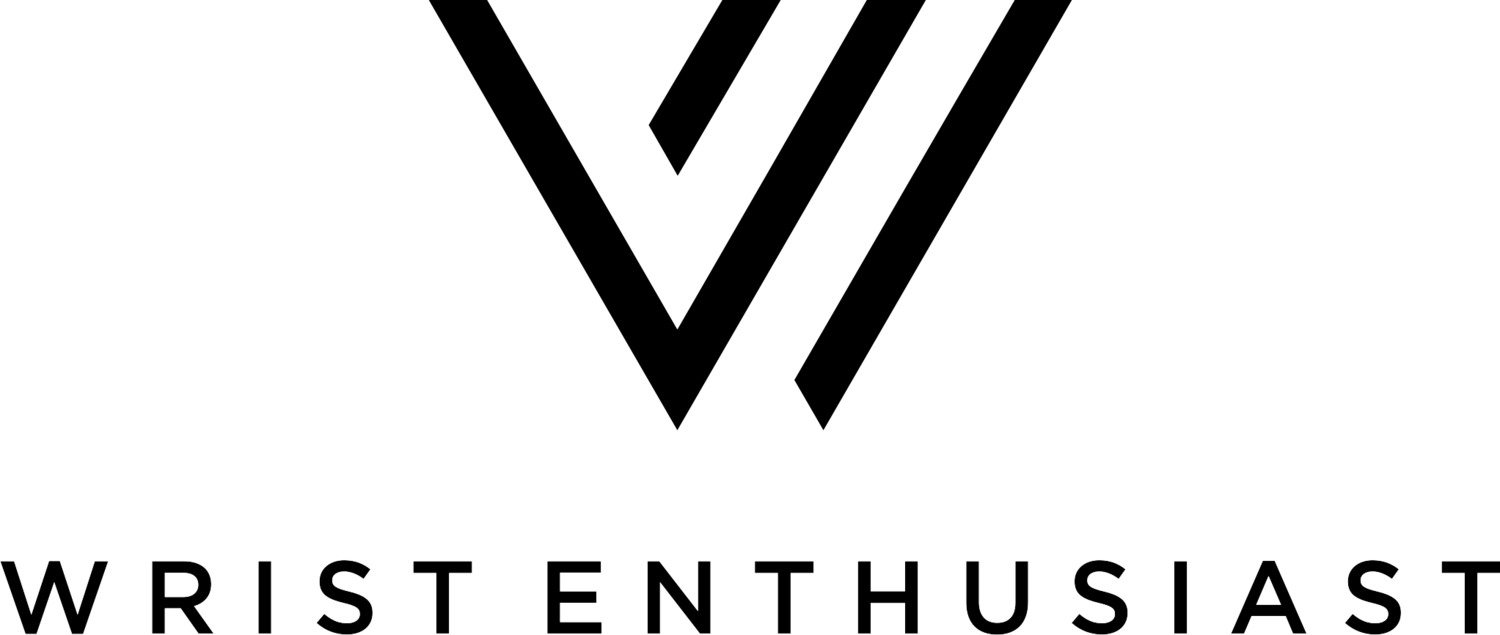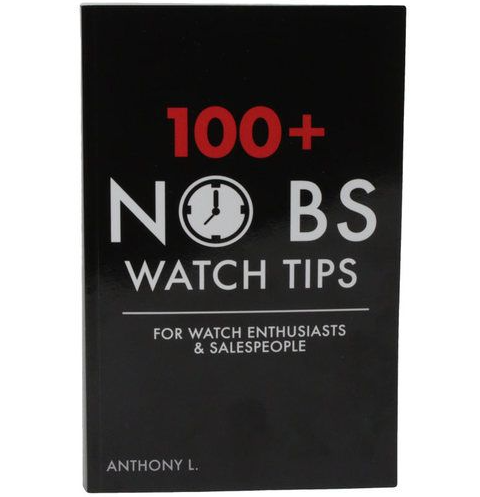100+ No BS Watch Tips for Watch Enthusiasts and Sales People Book Review
If you've ever picked up a "Basics of Watchmaking" book over the last century, you'll be able to relate to how lackluster and rigged educational material on the subject is. It's no secret that picking up a textbook for watchmaking basics would put a Mountain Dew chugging toddler to sleep, and that's a challenging subject to tackle without coma inducing verbiage and exhaustively complex explanations. "Anthony L.", better known by his Instagram handle @nobswatchmaker, has written 100+ No BS Watch Tips for Watch Enthusiasts & Salespeople. The book culminates "100+" of his tips and advice to educate readers on not only watches in general, but some insight into inner-workings watchmaking and the watch industry.
The Author
Anthony is a watchmaker working out of New York City. He has long run an Instagram account and a website that has given his followers an inside look at the often un-glamorous life of a watchmaker, though, really I would say it's mostly a quirky and entertaining education platform for people interested in the profession. What I've appreciated most about Anthony over *insert any well known watchmakers account here* is how well he's able to articulate the complexity and nuances of watchmaking in a fun way, and without sounding pretentious or condescending - mostly due to how he got into it in the first place.
Anthony started working on watches at 12 years old. He started at 5:30am went to school by 8am, then returned to work on watches in the evening... day in and day out. Because of that, enough resentment was built up towards watchmaking during his childhood that its allowed him to share a critical look at the flaws of an industry known for dancing around it's own shortcomings. It wasn't until well into his 20's that he realized and respected the profession which further allowed for him to find a voice in educating his readers with brutally honest looks into the industry. In other words, a lot of readers find it refreshing to learn from someone who honestly answers questions that don't fall into the "rainbows and unicorn" image you often get from a brands marketing material.
What is the goal of the book?
100+ No BS Watch Tips for Watch Enthusiasts & Salespeople is an educational tool on the basics of watchmaking and how the industry operates. Anthony wrote the book to educate readers on watchmaking, industry norms, and retail experience, while cutting through "BS" misinformation while making it fun and easy to care about. Unless you are dead-set on becoming a watchmaker, reading traditional material easily turns people off. The book takes a lighthearted but honest approach to watchmaking, the industry, retail, and education that isn't only engaging, but enjoyable to read.
While it's not directly mentioned in the book (and honestly it would come off as a bit idiomatic), I feel that this book fits beautifully as an aid for the hobby enthusiast or anyone who wants to understand watches and the industry better, and an easy read for people who are on the fence about whether they want to be a watchmaker or not. The book doesn't just stick to the shallow end either. There is a lot of information that watch "veterans" can learn from as well. The no-nonsense-but-still-quirky look into some pretty nuanced and in-depth topics makes the book a utility for newcomers and seasoned enthusiasts.
What's in the book?
100+ No BS Watch Tips for Watch Enthusiasts & Salespeople covers a large swathe of common questions and information consumers should know before, during, or after they buy a watch - things as simple as the definition of a mechanical watch, on up to how to read a Timing Read-Out. Mixed in throughout the tips are tables, pictures, and guides outlining everything from what each number in a Rolex serial means, to drawings of mechanical components. One cool aspect is that it also takes an angle towards salespeople to help them better educate the customers that come through their doors. The information isn't only useful to a consumer, but to a sales team as well. Through a number of tips, Anthony covers scenario's where a salesperson could have done a better job educating the customer and avoiding headaches for everyone involved.
For example, "How often should I get my watch serviced?" isn't always a straight forward answer. There are dependencies and nuances about the kind of watch, brand of watch, and movement that would determine whether it needs a service every year, or every ten years. But that information is not always something the customer walks away understanding, thus, leading to overhauls due to lack of care or misunderstandings about what constitutes a service and when a service is required. It can also avoid the awkward conversation as to why a service is so expensive or even needed when the watch costs so much. He even talks about scenarios where customers bring their mechanical watches in for a battery change because they left without understanding what a mechanical watch was. So not only do you as the reader have the information for when your watch needs serviced, but the tip also serves as a friendly (or not friendly depending on the tip) reminder to a salesperson to educate their customer if they want to avoid a conflict.
The book isn't written with the tips in order of 1-100. In fact, it's a plethora of the basics in "no particular order" with a Table of Contents to reference each specific tip. For instance a question like "Do I need to demagnetize my Quartz watch?" can be referenced on page 161, under watch tip #43... followed by Page 162 which is watch tip #89. While it seems unnecessary in a sense, I largely appreciated the ability to skip around without really paying attention to where I left off. I can say that if you're a stickler for a structured narrative, this is going to throw you for a loop. At first, I felt a little confused, but after my initial cover-to-cover read, I found myself skipping around to different portions I was interested in - as intended.
The drive for most of the tips are customer stories and experiences he's had in dealing with them. That makes the book really easy to read. Being able to back some of the tips with actual examples from actual experiences makes a typically bland subject fun and relate-able. Anthony's writing style is highly conversational, sarcastic, and witty - unconventional when we are talking about the watch industry. That being said, there were times I forgot I was reading a book by a watchmaker. Peppered throughout are rants (touch his watchmakers bench, see what happens), warnings, and industry insight that Anthony writes with humor and candor. When paired with the lack of structure, the book flows more like a conversation than a textbook. While pertinent information does get covered, it feels more like a Q&A than classroom study - which helps relate to readers who may not be focused enough to sit and read a chapter on how they can run a Quality Control check on their Rolex.
Conclusion
100+ No BS Watch Tips for Watch Enthusiasts & Salespeople won't be for everyone, but it was for me. I found it to simply be an enjoyable read about a hobby I'm passionate about, written by a watchmaker who's infinitely more knowledgeable about crafting and shaping what's inside of a watch case. Were their editorial flaws in the book? Yes. Did Anthony run down some rabbit holes at times? Yes. But like any good conversation with any passionate individual, that comes with the territory. Anthony proved to be a great voice into the world of watchmaking. The book does a fantastic job of delving into complex, albeit, common questions and advice, without feeling pretentious - all while effectively navigating through "industry speak" or "BS".
I would recommend this book to anyone who may be interested in a unique watchmaking perspective that doesn't have the patience to sit through lectures, or read an ordinary "watch basics" book. 100+ No BS Watch Tips for Watch Enthusiasts & Salespeople treads the line of entertainment and education - making it a light read that still packs a lot of information into less than 300 pages.
You can pick up the book on Amazon for around $30.


